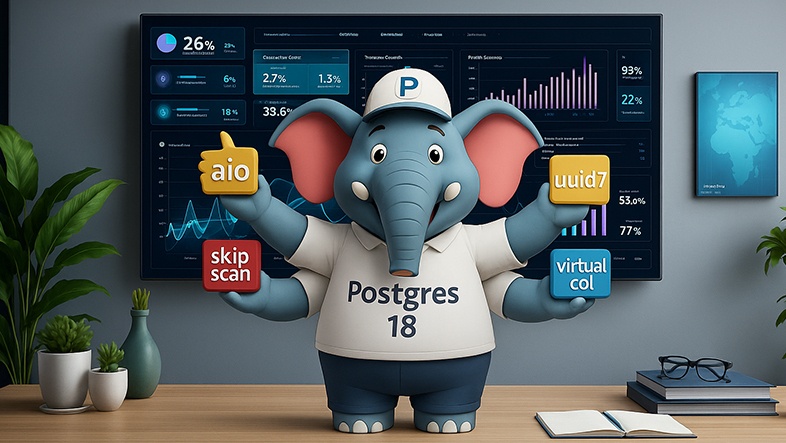

Table of Contents
When PostgreSQL 18 arrived this fall, database communities everywhere focused on its headline features: screaming-fast asynchronous I/O, smarter indexing, new developer magic like UUIDv7, and a leap forward in security. But beneath the surface is a quieter revolution—a profound transformation in database observability and diagnostics. This blog dives deep into both the generics everyone is talking about, and the under-explored impact of PostgreSQL 18’s real-time transparency features that make every DBA, DevOps, and developer’s life easier.
What’s New & Trending in PostgreSQL 18
Asynchronous I/O:
PostgreSQL’s historic shift from synchronous to asynchronous I/O (AIO) means disk reads and maintenance tasks can be executed in parallel, slashing latency and unlocking 2–3x read throughput for sequential scans, bitmap heap scans, and routine maintenance like VACUUM. This is especially valuable in cloud environments where parallelism is king.
B-tree Skip Scan Indexing:
Now, queries missing leading columns on multi-column B-tree indexes can still leverage those indexes. No more fallback to slow table scans—the planner “skips” over non-relevant index sections, boosting analytics and heavy reporting workloads.
UUIDv7 Support:
PostgreSQL 18 adds native support for UUID version 7, embedding sortable timestamps into unique identifiers for globally distributed and high concurrency systems. Fast inserts, naturally ordered data, fewer index page splits—ideal for modern, distributed apps.
Developer Convenience:
- Virtual Generated Columns: Calculate values on read, not write, for schema flexibility and lighter tables.
- Enhanced RETURNING Clause: Easier access to both “old” and “new” values for audit-friendly changes.
- Temporal Constraints & SQL Compliance: WITHOUT OVERLAPS, NOT VALID, and NOT ENFORCED constraints modernize schema management.
Security for Enterprises:
- OAuth 2.0 Authentication: Plug into Okta, Keycloak, Microsoft Entra, and other SSO solutions. No more long-term passwords lingering in configs.
- TLS and Encryption Upgrades: Default checksums and fine-grained cipher suite controls mean stronger data integrity.
Cloud and AI Readiness:
- New Index APIs & Dynamic Extensions: Ready for vector search, advanced analytics, and modular extension loading in cloud/Kubernetes environments.
The Deep Dive: Real-Time Monitoring, Diagnostics, and Observability
PostgreSQL 18 isn’t just faster—it’s more transparent and easier to manage than ever before. Here’s what most blogs overlook:
- Byte- and Connection-Level Stats for Every Backend and WAL
New system views now provide byte-level read, write, and WAL statistics per connection and process. DBAs can instantly answer:
- Who’s consuming the most I/O and why?
- Which queries hammer disk or log buffers?
- Where exactly is bloat, contention, or slowdown?
No more guesswork—root cause analysis goes from hours to minutes.
- EXPLAIN Output: Now With Buffers, WAL, and More
EXPLAIN ANALYZE now shows not just planner costs, but how many shared buffers, index lookups, backend cache workers, WAL writes, and disk/CPU cycles each node engaged. This means you can:
- Compare before/after plans to validate upgrades.
- Tune queries by seeing how they touch hardware resources.
- Identify “mystery slowness” linked to unexpected I/O patterns.
- Upgrade Without Blind Spots
Upgrades used to force you to rebuild planner statistics from scratch, painful for large installations. PostgreSQL 18 now lets you preserve statistics, enabling instant post-upgrade performance validation. No more waiting days for stats to rebuild before you can trust your database in production.
- Operational & Maintenance Diagnostics
- VACUUM/ANALYZE Timing: System tables and logs now track detailed maintenance timing, enabling bottleneck analysis for autovacuum and more granular scheduling.
- Logical Replication Conflict Tracking: Diagnose and resolve replication issues in real-time with live views of write conflicts.
- Better Lock Acquisition Logs: Pinpoint lock contention and query queueing issues before they cascade.
- Automation Opportunities
With richer metrics, it’s easier to automate health checks, anomaly detection, and tuning scripts—all backed by hard data, not assumptions. This is huge for large-scale SaaS, fintech, and analytics deployments.
Why Is This So Critical?
In today’s data-driven landscape, performance isOperational & Maintenance Diagnosticsn’t just about speed—it’s about predictability, transparency, and operational control. For regulated industries or mission-critical applications, PostgreSQL 18’s real-time observability is as game-changing as any speed boost.
- DBAs gain instant, actionable insights for troubleshooting and capacity planning.
- DevOps unlock automated validation for continuous deployment and upgrades.
- Developers can debug and optimize with concrete query and backend-level stats.
Final Thoughts
PostgreSQL 18 sets the standard for performance, developer productivity, and operational clarity. Upgrade if you need speed, but most of all if you crave certainty—the confidence that comes from real-time, byte-level, connection-aware transparency across your entire data stack.
Whether you’re a developer curious about UUIDv7 or a DBA searching for the source of “mystery I/O spikes,” PostgreSQL 18 doesn’t just answer your questions—it changes the questions you can ask.
If you want faster queries and peace of mind, it’s time to get excited about monitoring, observability, and everything else PostgreSQL 18 has to offer.




